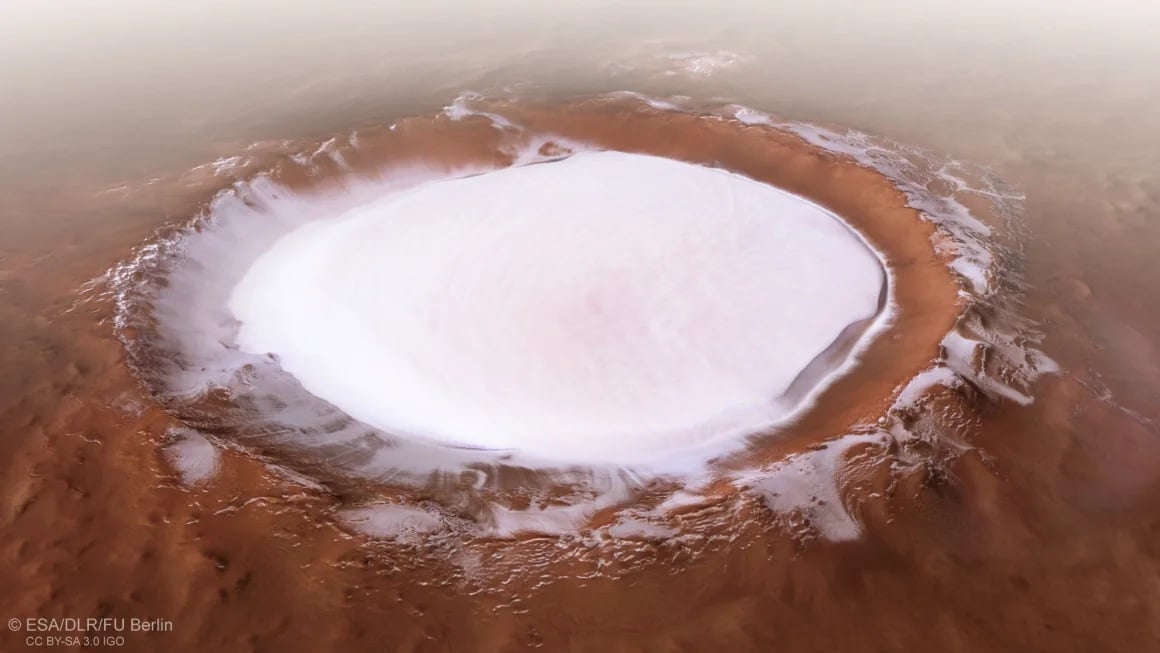Science
Japanese Researchers Uncover Mars’ Climate History in Ice Deposits

Research conducted by a team from Japan has revealed significant insights into Mars’ climatic history, suggesting that ice deposits within the planet’s craters serve as a record of its past environmental conditions. For decades, scientists have examined various features on Mars that indicate a warmer, wetter planet, characterized by rivers, lakes, and an ocean that once dominated its northern hemisphere.
The study, published in the journal Geology, was led by Trishit Ruj, an associate professor at the Institute for Planetary Materials at Okayama University. The research highlights how these ice deposits have recorded multiple ice ages over the last hundreds of millions of years. The findings suggest a gradual decline in the amount of ice, indicating that Mars has been losing its water over extensive geological time.
Insights from Martian Craters
The research team focused on glacial landforms preserved in craters located between 20°N and 45°N latitude. Using high-resolution images from the Context Camera and the High-Resolution Imaging Science Experiment aboard NASA’s Mars Reconnaissance Orbiter, they identified features indicative of past glaciation, such as ridges and maze-like pit formations.
They found that the ice consistently clustered on the shadowed southwestern walls of the craters, a pattern that remained stable throughout multiple glacial periods during the Amazonian period, which spanned from approximately 640 million to 98 million years ago. Ruj noted that shifts in Mars’ axial tilt, or obliquity, influenced these climatic changes, similar to Earth’s own axial variations. While Mars’ obliquity can change dramatically over time, leading to cycles of glaciation and warming, Earth’s tilt remains more stable.
Implications for Future Exploration
This research not only sheds light on the historical climate of Mars but also has substantial implications for future crewed missions. As astronauts prepare for exploration, understanding the locations and accessibility of water ice will be vital for sustaining human life on Mars. Water ice can be utilized for growing food, producing oxygen, and creating fuel. Given the logistical challenges of travel between Earth and Mars, with conventional spacecraft taking six to nine months for a one-way journey, in-situ resource utilization (ISRU) becomes essential.
The study’s findings could also inform efforts to address climate challenges on Earth. As rising global temperatures lead to shrinking glaciers and ice caps, the same imaging and modeling techniques applied to examine Martian ice could assist scientists in monitoring our planet’s water resources.
Dr. Hasegawa from Kochi University remarked, “Mars serves as a natural laboratory for understanding how ice behaves over vast timescales. The insights we gain here can sharpen our understanding of climate processes on Earth as well.”
As researchers continue to unravel the mysteries of Mars, the knowledge gained may not only pave the way for interplanetary exploration but also provide valuable lessons for managing Earth’s changing climate.
-

 Business1 week ago
Business1 week agoIconic Sand Dollar Social Club Listed for $3 Million in Folly Beach
-

 Politics1 week ago
Politics1 week agoAfghan Refugee Detained by ICE After Asylum Hearing in New York
-

 Health1 week ago
Health1 week agoPeptilogics Secures $78 Million to Combat Prosthetic Joint Infections
-

 Science1 week ago
Science1 week agoResearchers Achieve Fastest Genome Sequencing in Under Four Hours
-

 Lifestyle1 week ago
Lifestyle1 week agoJump for Good: San Clemente Pier Fundraiser Allows Legal Leaps
-

 Health1 week ago
Health1 week agoResearcher Uncovers Zika Virus Pathway to Placenta Using Nanotubes
-

 World1 week ago
World1 week agoUS Passport Ranks Drop Out of Top 10 for First Time Ever
-

 Business1 week ago
Business1 week agoSan Jose High-Rise Faces Foreclosure Over $182.5 Million Loan
-

 World1 week ago
World1 week agoRegional Pilots’ Salaries Surge to Six Figures in 2025
-

 Science1 week ago
Science1 week agoMars Observed: Detailed Imaging Reveals Dust Avalanche Dynamics
-

 Entertainment1 week ago
Entertainment1 week agoJennifer Lopez Addresses A-Rod Split in Candid Interview
-

 Top Stories1 week ago
Top Stories1 week agoChicago Symphony Orchestra Dazzles with Berlioz Under Mäkelä









